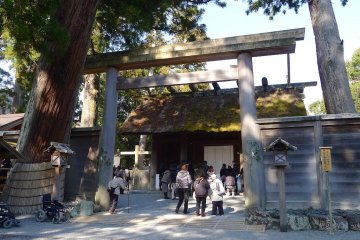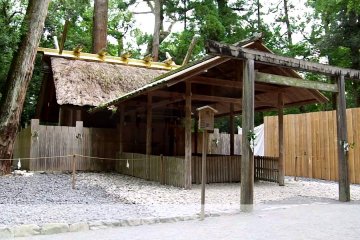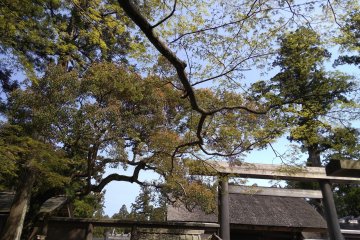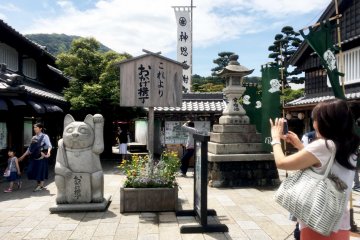
The Grand Ise Jingu
Chris GlennThe Grand Shrine of Ise comprises two separate shrines, the Naiku and Geku. From ancient times, worshippers would visit the Geku first, then the Naiku.

Located in Mie Prefecture, the Ise Grand Shrine is a Shinto shrine dedicated to the sun goddess. Supposedly, the shrine or “Jingu” as it is commonly called, is home to the Sacred Mirror; this mirror was the one that drew Amaterasu from hiding and brought light back to the world. In reality, Ise Jingu is a complex of shrines centered around two main shrines, Naiku and Geku.
The inner shrine is Naiku, said to be where Amaterasu dwells even today. Whereas the outer shrine, Geku, is located about six kilometers from Naiku and dedicated to Toyouke-Omikami, the god of agriculture, rice, and harvest. There are an additional 123 shrines in Ise City surrounding both Naiku and Geku. The shrine buildings at Naiku and Geku are rebuilt every 20 years based upon a Shinto belief of death and renewal.
The shrine was established in 4 BCE when Princess Yamatohime no Mikoto wandered for twenty years looking for a place to worship the sun goddess. Upon arriving in Ise, Yamatohime received a message from Amaterasu saying that this was the land where she wished to reside. Today, only a person of the royal lineage may be the high priest or priestess of Ise Jingu.
Hidden in Oharai, a small town near Ise Jingu, the Okage Yokocho (gratitude side street) opened in 1993. Here, the buildings are constructed in reverence to the gods of the Shinto shrines of Ise. You’ll find souvenir shops and restaurants aplenty along this old-fashioned side street—it’s open daily from 9:30 to 5:30 pm.
The inner and outer shrines are some 6 kilometers apart, therefore it's recommended that you visit by bus. Buses depart from Ujiyamada and Iseshi stations.

The Grand Shrine of Ise comprises two separate shrines, the Naiku and Geku. From ancient times, worshippers would visit the Geku first, then the Naiku.

A collection of photos from Ise Jingu during the busy New Year's season

Ise Jingu in Ise City is the most sacred Shinto shrine in Japan. Last year (2013) the famous Shikinen Sengu ceremony was held again, when the shrine is completely rebuilt, every twenty years. However, it is not all about the shrine buildings; pilgrimage has always played an important role in this area and eating and drinking on the way was important. So just like in the past, having some food before approaching or after visiting the grand shrine is indispensable. The famous dishes here are Akafuku (mochi covered in sweet red bean paste) and Ise Udon (udon soaked in soy-based sauce).

After the countdown, make way for hatsumode — the first shrine visit of the new year — at the Ise Grand Shrine

One of the main shrines of the Ise Jingu Complex, Geku, has enshrined the god of food, clothing and shelter since 1500 years ago

Geku and Naiku shine at Ise Jingu because they are full of myth, history, mystique, and are a long lasting testament to faith. Both enshrine goddesses, of whom Amaterasu is a centrifugal force of Shintoism.

Ise Jingu's Naiku enshrines the God of the Sun. It is the ancestor God of the Emperor, and the ancestor God of all Japanese!

Dedicated to Amaterasu, Goddess of the Sun, Ise Jingu is the most sacred Shinto Shrine in Japan. Set within an ancient forest, pilgrims have been drawn by its mystery and spirituality for close 2,000 years.

Ise Guesthouse Kazami offers more than just the cheapest bed in town


Looking like a shrine, temple & small castle all rolled into one, the traditional Japanese Hinjitsukan structure was operated as an exclusive inn for royalty.

Ise-Shima National Park in Mie Prefecture is well-known for its legendary Ise Lobster. But, are you brave enough to try Ise Lobster in soft ice cream?

For the first time in its century-old history, the National Confectionery Expo is being held in Mie Prefecture, from Friday April 21st to Sunday May 14th 2017. Tickets are ¥1,800 for advance reservation and ¥2,000 at the gate. Official website in English: http://www.kashihaku-mie.jp.e.yk.hp.transer.com/

Oharai-machi (おはらい町) is a small traditional town that prospered outside the gates of the entrance of Ise Jingu Shrine — Japan's most sacred shrine. As a traditional approach, it spans almost one kilometer in length and is lined with a variety of shops and restaurants.

In Mie Prefecture, not far from the city of Futami, which belongs to the city of Ise, are the Meoto Iwa rocks, which are also called" The Married Rocks ". These two sacred rocks in the sea near the coast are not far from the Futami-Okitama Shrine, the Ryuugu Shrine and also near the famous Ise Shrine itself. The two rocks are connected with a so-called Shimenawa. This is a ritual rope made of rice straw. This fact gave them the nickname "The Married Rocks" In the belief of the Shinto religion, these two rocks represent the union of the pair of gods Izanagi and Izanami, who, according to legend, are the two central gods "Kami" in the myth of the origin of Japan.
